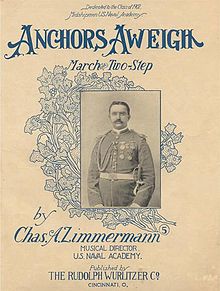Anchors Aweigh (March)
Anchors Aweigh (in German common title Anker auf or Anchor lighted ) is an American military march . Composed in 1906 by Charles A. Zimmermann (1861-1916), then Kapellmeister of the United States Naval Academy Band , as a march for football games , it has since become the most played piece of the US Navy and is considered the unofficial anthem of the United States Navy .
Emergence
Lieutenant Charles A. Zimmermann, a graduate of the Peabody Conservatory and conductor of the United States Naval Academy Band since 1887, composed a march for the traditional football game between the US Naval Academy and the Military Academy of the US Army in 1906 at the request of Midshipman First Class Alfred Hart Miles . Miles also contributed the text for the march, which premiered on December 1, 1906 at the game at Franklin Field in Philadelphia in the Navy 10-0 victory.
text
Original text from 1906:
- Stand Navy down the field, sails set to the sky.
- We'll never change our course, so Army you steer shy-yyy.
- Roll up the score, Navy, Anchors Aweigh.
- Sail Navy down the field and sink the Army, sink the Army Gray.
- Get underway, Navy, Decks cleared for the fray,
- We'll hoist true Navy Blue So Army down your Gray-yyy.
- Full speed ahead, Navy; Army heave to,
- Furl Black the Gray and Gold and hoist the Navy, hoist the Navy Blue
Revised text from 1920, mostly only the second verse is sung:
- Stand, Navy, out to sea, Fight our battle cry;
- We'll never change our course, So vicious foe steer shy-yyy.
- Roll out the TNT, Anchors Aweigh. Sail on to victory
- And sink their bones to Davy Jones, hooray!
- Anchors Aweigh, my boys, Anchors Aweigh.
- Farewell to college joys, we sail at break of day-ay-ay-ay.
- Through our last night on shore, drink to the foam,
- Until we meet once more: Here's wishing you a happy voyage home.
Adaptation
Anchors Aweigh plays an important role in official ceremonies of the Navy and the Naval Academy, but the piece also found its way into American culture. Many schools and universities use the melody, mostly with a different text, as their own anthem, as do sports clubs, sometimes even in Australia. The song - played by the Hamburg Police Orchestra - is an integral part of the Hamburg Harbor Concert .
A proposal to make the piece the official anthem of the US Navy and to include it in the Navy Regulations was not taken up (as of 2019).
References
Web links
- Anchors Aweigh in the US Navy
Individual evidence
- ↑ a b Library of Congress , as of October 25, 2007
